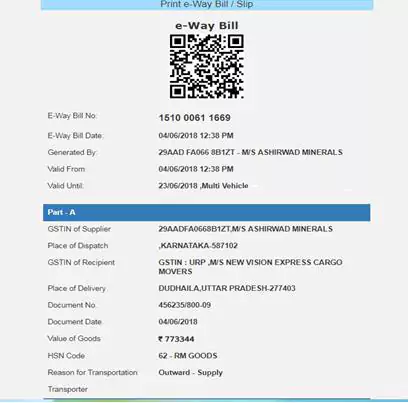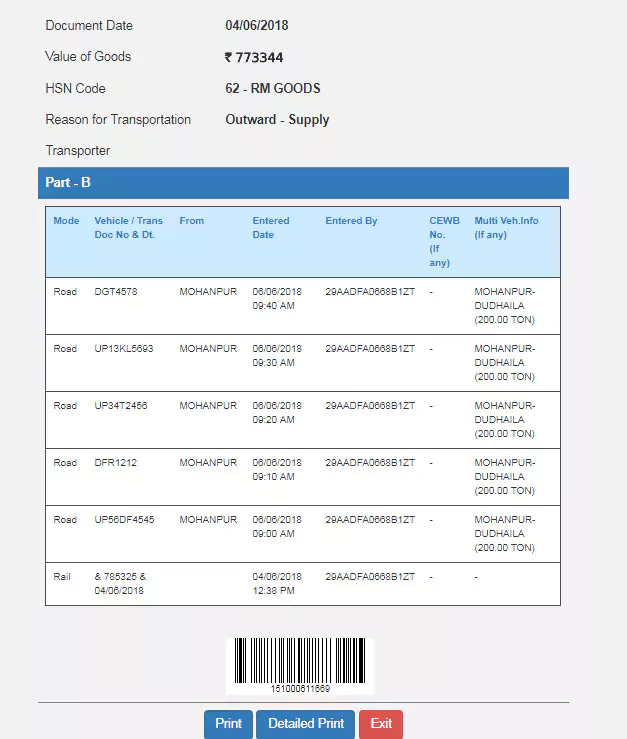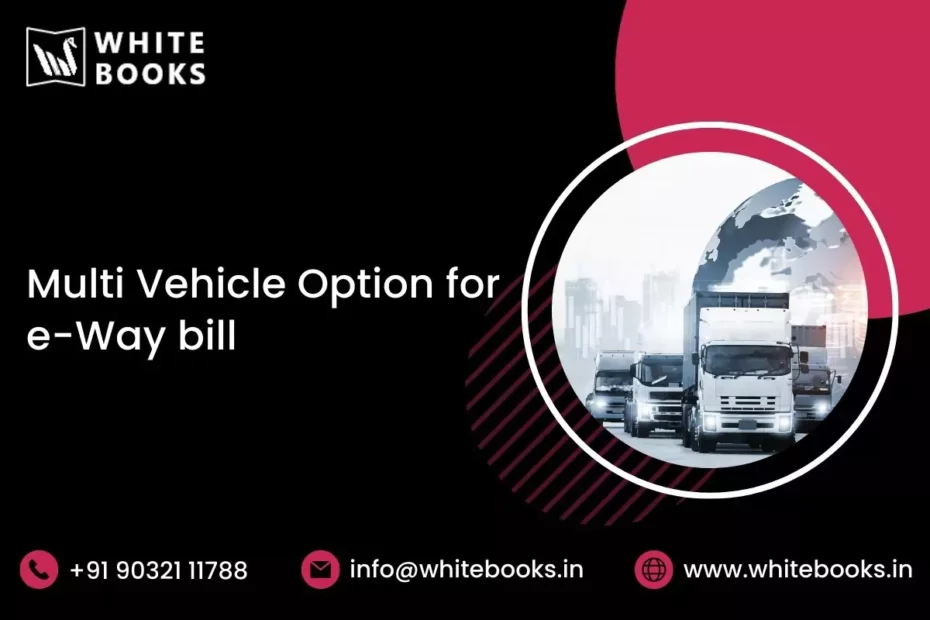Table of Contents
1. Efficient Transshipment with e-Way Bill Multi-Vehicle Option
The Multi Vehicle Option for e-Way bill allows for the movement of a consignment in multiple vehicles after reaching a transshipment point. This feature addresses scenarios where continuing transportation using the same mode or larger vehicles is not feasible.
To illustrate, let’s consider a situation where an e-way bill is generated for transporting goods from point A to point C. However, the consignment initially moves from point A to point B using rail or a larger vehicle. Due to certain constraints like the unavailability of the same mode of transportation or challenging terrain that restricts the use of bigger vehicles, it becomes necessary to transfer the consignment to multiple smaller vehicles for further transportation.
In such cases, the Multi-Vehicle Option allows the e-way bill to be modified for multi-vehicle movement. The total quantity of the consignment and the movement details between the places for each vehicle involved need to be entered. This ensures accurate tracking and compliance with the declared quantity during the multi-vehicle shipment.
To initiate the process, the e-way bill is first generated with the source and destination as per the document/invoice. The first leg of movement takes place up to the transshipment point. Then, the ‘Change to Multi-vehicle’ option is selected to update the e-way bill for multi-vehicle movement.
As the consignment is loaded onto each smaller vehicle, the ‘Part B’ of the e-way bill is updated with the respective vehicle number and the quantity loaded. This process can be repeated until the entire consignment is loaded and moved. The system prevents the shipment of quantities exceeding what was declared while marking the e-way bill for multi-vehicle movement.
Introducing the Multi-Vehicle Option in the e-way bill system facilitates seamless logistics by accommodating the need for consignments to be transported in multiple vehicles when the same mode or larger vehicles are not viable. It enables efficient and compliant movement of goods across various transportation modes, ensuring smooth operations in complex logistical scenarios.
2. Utilizing the Multi-Vehicle Option in e-Way Bill Generation
To address this need, a new option has been introduced in e-way bill generation that allows for multi-vehicle movement of a single consignment. By following these steps, businesses can seamlessly manage the movement of their consignments across multiple vehicles, ensuring timely delivery and compliance with e-way bill regulations. Let’s dive in!
- Step 1: Generate an e-Way Bill with Source and Destination Details to initiate the process, generate the e-way bill with accurate source and destination information as per the document or invoice. This provides the initial framework for the consignment movement.
- Step 2: Complete the First Leg of the Consignment Movement Transport the consignment from the source location to the transshipment point using the selected mode of transportation. This leg of the movement sets the foundation for further transportation.
- Step 3: Update the e-Way Bill for Multi-Vehicle Movement access the e-way bill system and select the ‘Change to Multi-vehicle’ option. Here, you will need to update the e-way bill with the total quantity of the consignment and specify the movement from and to places for the multiple vehicles involved.
- Step 4: Update ‘PartB’ of the e-Way Bill once the consignment is loaded onto a smaller vehicle for further movement, updating the ‘PartB’ section of the e-way bill is essential. Enter the vehicle number and quantity loaded to track the consignment’s progress accurately.
- Step 5: Repeat Step 4 for Remaining Quantity If the total quantity of the consignment requires multiple vehicles, repeat Step 4 until the entire quantity is loaded and moved. The e-way bill system ensures that the quantity shipped in multiple vehicles does not exceed the declared quantity, maintaining compliance with regulations.
By following these steps, businesses can effectively utilize the multi-vehicle option in e-way bill generation, enabling the seamless movement of consignments across different vehicles. This feature enhances flexibility in logistics operations, allowing for efficient transportation even in complex scenarios.
3. Detailed Explanation:
To utilize the multi-vehicle option in e-way bill generation, follow these steps:
- Access the e-way bill system and navigate to the menu options.
- Look for the ‘Change to Multi Vehicle’ option and select it.
- Enter the e-way bill number you want to change for multiple vehicle movements.
- Submit the request, and the system will retrieve the details associated with the e-way bill.
Once you have initiated the process, the system will display the relevant information related to the e-way bill, including the source and destination details, consignment quantity, and movement requirements.
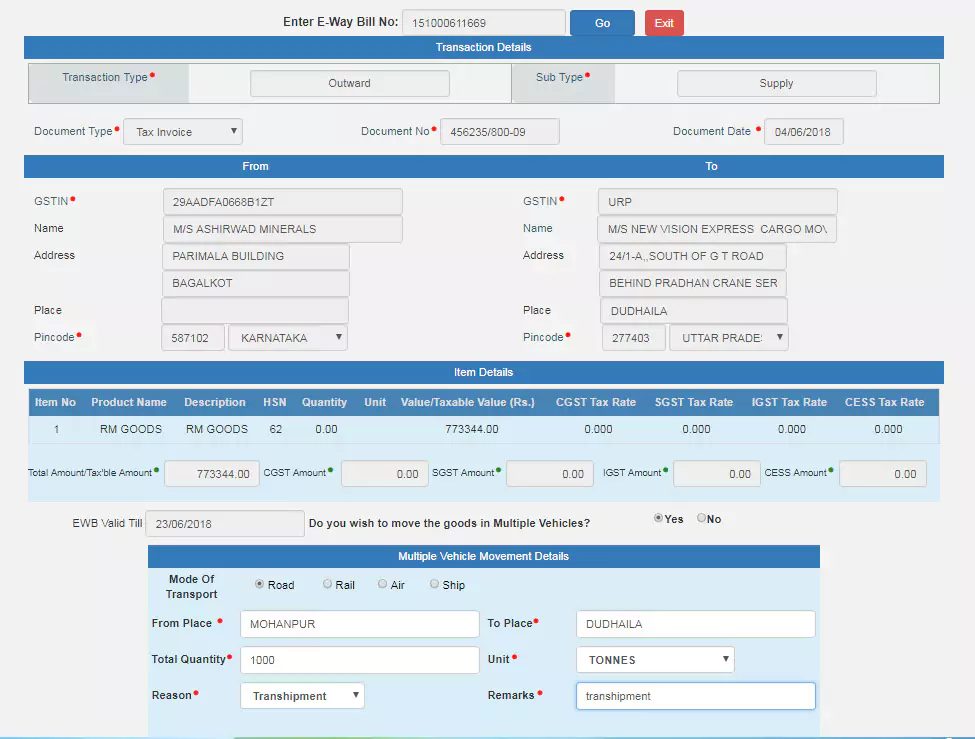
A new feature has been introduced that allows the transportation of a single consignment, covered by an e-way bill, in multiple vehicles after reaching a transshipment point.
For instance, let’s consider an e-way bill generated for moving goods from location A to location C. The consignment initially travels from A to B using a rail or larger vehicle. However, it is not feasible to continue the journey from B to C using the same mode of transportation due to various factors, such as the unavailability of the mode or the presence of hilly terrain unsuitable for large vehicles. In such scenarios, the consignment must be divided and transported in multiple smaller vehicles.
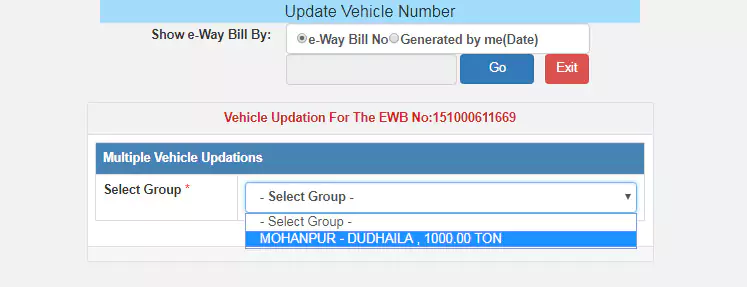
Now, enter the vehicle details as usual along with the quantity being moved and submit.
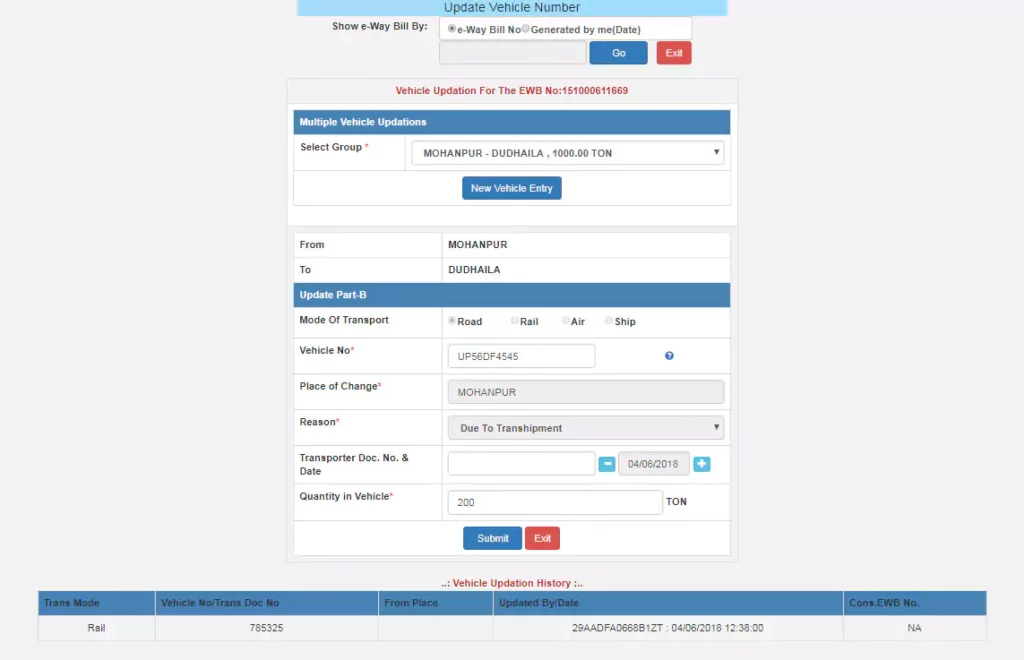
The printed version of the e-way bill displays the relevant information. Pay attention to the “Valid until” column, which indicates the validity of the multi-vehicle option. Additionally, the Part-B section of the e-way bill includes details such as the “from the place – to place” movement and the corresponding quantity being transported. This functionality enables the convenient split movement of a single consignment covered by an e-way bill.
